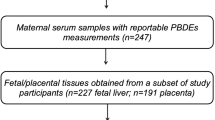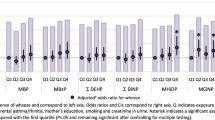Abstract
Parabens are widely used preservatives suspected of being endocrine disruptors, with implications for human growth and development. The most common paraben found in consumer products is methylparaben. To date, no study has examined whether these substances cross the human placenta. A total of 100 study subjects (50 mother–child pairs) were enrolled at two medical institutions, serving primarily African-American and Caucasian women, respectively. A maternal blood sample was drawn on admission and a paired cord blood sample was obtained at delivery. Of the 50 mothers, 47 (94%) showed methylparaben in their blood (mean level 20.41 ng/l), and 47 in cords bloods (mean level 36.54 ng/l). There were 45 mother–child pairs where methylparaben was found in both samples. Of these, the fetal level was higher than the maternal level in 23 (51%). For butylparaben, only 4 mothers (8%) showed detectable levels (mean 40.54 ng/l), whereas 8 cord blood samples (16%) were positive (mean 32.5 ng/l). African-American mothers and infants showed higher prevalence of detectable levels (P=0.017). Methylparaben and butylparaben demonstrate transplacental passage. Additional studies are needed to examine potential differences in exposure by geography and demographics, what products are used by pregnant women that contain these preservatives, as well as any potential long-term effects in the growth and development of exposed children.
This is a preview of subscription content, access via your institution
Access options
Subscribe to this journal
Receive 6 print issues and online access
$259.00 per year
only $43.17 per issue
Buy this article
- Purchase on Springer Link
- Instant access to full article PDF
Prices may be subject to local taxes which are calculated during checkout
Similar content being viewed by others
References
Darbre PD, Harvey PW . Paraben esters: review of recent studies of endocrine toxicity, absorption, esterase and human exposure, and discussion of potential human health risks. J Appl Toxicol 2008; 28: 561–578.
Rastogi SC, Schouten A, de Kruijf N, Weijland JW . Contents of methyl-, ethyl-, propyl-, butyl- and benzylparaben in cosmetic products. Contact Dermatitis 1995; 32: 28–30.
Ali EH, Elgoly AH . Combined prenatal and postnatal butyl paraben exposure produces autism-like symptoms in offspring: comparison with valproic acid autistic model. Pharmacol Biochem Behav 2013; 111: 102–110.
Boberg J, Metzdorff S, Wortziger R, Axelstad M, Brokken L, Vinggaard AM et al. Impact of diisobutyl phthalate and other PPAR agonists on steroidogenesis and plasma insulin and leptin levels in fetal rats. Toxicology 2008; 250: 75–81.
Boberg J, Taxvig C, Christiansen S, Hass U . Possible endocrine disrupting effects of parabens and their metabolites. Reproduct Toxicol 2010; 30: 301–312.
Chen J, Ahn KC, Gee NA, Gee SJ, Hammock BD, Lasley BL et al. Antiandrogenic properties of parabens and other phenolic containing small molecules in personal care products. Toxicol Appl Pharmacol 2007; 221: 278–284.
Harvey PW . Parabens, oestrogenicity, underarm cosmetics and breast cancer: a perspective on a hypothesis. J Appl Toxicol 2003; 23: 285–288.
Shaw J, deCatanzaro D . Estrogenicity of parabens revisited: impact of parabens on early pregnancy and an uterotrophic assay in mice. Reproduct Toxicol 2009; 28: 26–31.
Taxvig C, Vinggaard AM, Hass U, Axelstad M, Boberg J, Hansen PR et al. Do parabens have the ability to interfere with steroidogenesis? Toxicol Sci 2008; 106: 206–213.
Terasaka S, Inoue A, Tanji M, Kiyama R . Expression profiling of estrogen-responsive genes in breast cancer cells treated with alkylphenols, chlorinated phenols, parabens, or bis- and benzoylphenols for evaluation of estrogenic activity. Toxicol Lett 2006; 163: 130–141.
van Meeuwen JA, van Son O, Piersma AH, de Jong PC, van den Berg M . Aromatase inhibiting and combined estrogenic effects of parabens and estrogenic effects of other additives in cosmetics. Toxicol Appl Pharmacol 2008; 230: 372–382.
Calafat AM, Ye X, Wong LY, hop AM, Needham LL . Urinary concentrations of four parabens in the U.S. population: NHANES 2005-2006. Environ Health Perspect 2010; 118: 679–685.
Engel LS, Buckley JP, Yang G, Liao LM, Satagopan J, Calafat AM et al. Predictors and variability of repeat measurements of urinary phenols and parabens in a cohort of shanghai women and men. Environ Health Perspect 2014; 122: 733–740.
Frederiksen H, Jorgensen N, Andersson AM . Parabens in urine, serum and seminal plasma from healthy Danish men determined by liquid chromatography-tandem mass spectrometry (LC-MS/MS). J Expos Sci Environ Epidemiol 2011; 21: 262–271.
Smith KW, Braun JM, Williams PL, Ehrlich S, Correia KF, Calafat AM et al. Predictors and variability of urinary paraben concentrations in men and women, including before and during pregnancy. Environ Health Perspect 2012; 120: 1538–1543.
Smith KW, Souter I, Dimitriadis I, Ehrlich S, Williams PL, Calafat AM et al. Urinary paraben concentrations and ovarian aging among women from a fertility center. Environ Health Perspect 2013; 121: 1299–1305.
Tefre de Renzy-Martin K, Frederiksen H, Christensen JS, Boye Kyhl H, Andersson AM, Husby S et al. Current exposure of 200 pregnant Danish women to phthalates, parabens and phenols. Reproduction 2014; 147: 443–453.
Braun JM, Just AC, Williams PL, Smith KW, Calafat AM, Houser R et al. Personal care product use and urinary phthalate metabolite and paraben concentrations during pregnancy among women from a fertility clinic. J Expo Sci Environ Epidemiol 2014; 24: 459–466.
Zhang L, Dong L, Ding S, Qiao P, Wang C, Zhang M et al. Effects of n-butylparaben on steroidogenesis and spermatogenesis through changed E2 levels in male rat offspring. Environ Toxicol Pharmacol 2014; 37: 705–717.
Alam MS, Kurohmaru M . Disruption of Sertoli cell vimentin filaments in prepubertal rats: an acute effect of butylparaben in vivo and in vitro. Acta Histochem 2014; 116: 682–687.
Isling LK, Boberg J, Jacobsen PR, Mandrup KR, Axelstad M, Christiansen S et al. Late-life effects on rat reproductive system after developmental exposure to mixtures of endocrine disrupters. Reproduction 2014; 147: 465–476.
Ahn HJ, An BS, Jung EM, Yang H, Choi KC, Jeung EB et al. Parabens inhibit the early phase of folliculogenesis and steroidogenesis in the ovaries of neonatal rats. Mol Reprod Dev 2012; 79: 626–636.
Oishi S . Effects of propyl paraben on the male reproductive system. Food Chem Toxicol 2002; 40: 1807–1.
Oishi S . Lack of spermatotoxic effects of methyl and ethyl esters of p-hydroxybenzoic acid in rats. Food Chem Toxicol 2004; 42: 1845–1849.
Mathiesen L, Zuri G, Andersen MH, Knudsen LE . A proposed study on the transplacental transport of parabens in the human placental perfusion model. Altern Lab Anim 2013; 41: 473–482.
Vela-Soria F, Rodríguez I, Ballesteros O, Zafra-Gómez A, Ballesteros L, Cela R et al. Simplified matrix solid phase dispersion procedure for the determination of parabens and benzophenone-ultraviolet filters in human placental tissue samples. J Chromatogr A 2014; 1371: 39–47.
Hornung R.W., Reed L.D . Estimation of average concentration in the presence of nondetectable values. Appl Occup Environ Hyg 1990; 5: 46–51.
Author information
Authors and Affiliations
Corresponding author
Ethics declarations
Competing interests
The authors declare no conflict of interest.
Rights and permissions
About this article
Cite this article
Towers, C., Terry, P., Lewis, D. et al. Transplacental passage of antimicrobial paraben preservatives. J Expo Sci Environ Epidemiol 25, 604–607 (2015). https://doi.org/10.1038/jes.2015.27
Received:
Revised:
Accepted:
Published:
Issue Date:
DOI: https://doi.org/10.1038/jes.2015.27



